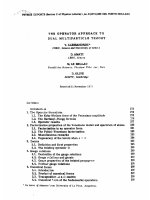THE SYSTEMS APPROACH TO CONTROL AND INSTRUMENTATION pdf
Bạn đang xem bản rút gọn của tài liệu. Xem và tải ngay bản đầy đủ của tài liệu tại đây (283.54 KB, 10 trang )
THE SYSTEMS APPROACH TO CONTROL AND INSTRUMENTATION
2
UNDERSTANDING AUTOMOTIVE ELECTRONICS
29
The Systems Approach to
Control and Instrumentation
Generally speaking, electronic systems function to control, measure, or
communicate. Automotive electronic systems fall generally into these same
three application areas. The major categories of automotive electronic systems
include
1. Engine/power train control
2. Ride/handling control
3. Cruise control
4. Braking/traction control
5. Instrumentation (instrument panel)
6. Power steering control
7. Occupant protection
8. Entertainment
9. Comfort control
10. Cellular phones
Historically, automotive electronics was confined primarily to
communications, with the incorporation of AM radios and police-car two-way
radio systems. These remained the only significant electronics applications
throughout the 1930s and 1940s. This was an era in which vacuum tubes were
the only important active electronic devices.
The development of solid-state electronics, beginning with the transistor
in the late 1940s and evolving through high-performance integrated circuits,
provided a technology that was compatible with the evolution of other
automotive electronic systems such as ignition systems, turn signals,
instrumentation, and a variety of other automotive subsystems. Perhaps the
biggest evolutionary jump occurred in the 1970s with the advent of electronic
fuel control systems, a step motivated primarily by government regulations (as
we will show later). Since then the evolution of electronic systems in
automobiles has seen spectacular growth, such that automotive electronics is
now estimated to account for 10% to 25% of the cost of the vehicle, depending
on feature content.
CHAPTER OVERVIEW
This book will discuss the application of electronics in automobiles,
from the standpoint of electronic systems and subsystems. In a sense, the
systems approach to describing automotive electronics is a way of organizing
2735 | CH 2 Page 29 Tuesday, March 10, 1998 10:55 AM
[]
41
2
THE SYSTEMS APPROACH TO CONTROL AND INSTRUMENTATION
30
UNDERSTANDING AUTOMOTIVE ELECTRONICS
the subject into its component parts based on functional groups. This chapter
will lay the foundation for a discussion by explaining the concepts of a system
and a subsystem, and how such systems function. The means for
characterizing the performance of any system will be explained so that the
reader will understand some of the relative benefits and limitations of
automotive electronic systems. This chapter will explain generally what a
system is and, more precisely, what an electronic system is. In addition, basic
concepts of electronic systems that are applicable to all automotive electronic
systems, such as structure (architecture) and quantitative performance analysis
principles, will be discussed.
Two major categories of electronic systems—analog or continuous time
and digital or discrete time—will be explained. In most cases, it is theoretically
possible to implement a given electronic system as either an analog or digital
system. The relatively low cost of digital electronics coupled with the high
performance achievable relative to analog electronics has led modern
automotive electronic system designers to choose digital rather than analog
realizations for new systems.
CONCEPT OF A SYSTEM
A
system
is a collection of components that function together to perform a
specific task. Various systems are encountered in everyday life. It is common
practice to refer to the bones of the human body as the skeletal system. The
collection of highways linking the country’s population centers is known as the
interstate freeway system.
Electronic systems are similar in the sense that they consist of collections of
electronic and electrical parts interconnected in such a way as to perform a specific
function. The components of an electronic system include transistors, diodes,
resistors, and capacitors, as well as standard electrical parts such as switches and
connectors among others. All of these components are interconnected with
individual wires or with printed circuit boards. In addition, many automotive
electronic systems incorporate specialized components known as
sensors
or
actuators
that enable the electronic system to interface with the appropriate
automotive mechanical systems.
Systems can often be
broken down into sub-
systems. The subsystems
also consist of a number
of individual parts.
Any electronic system can be described at various levels of abstraction,
from a pictorial description or a schematic drawing at the lowest level to a
block diagram at the highest level. For the purposes of the present discussion,
this higher-level abstraction is preferable. At this level, each functional
subsystem is characterized by inputs, outputs, and the relationship between
input and output. Normally only the system designer or maintenance
technician would be concerned with detailed schematics and the internal
workings of the system. Furthermore, the only practical way to cover the vast
range of automotive electronic systems is to limit our discussion to this so-
called system level of abstraction. It is important for the reader to realize that
there are typically many different circuit configurations capable of performing
a given function.
2735 | CH 2 Page 30 Tuesday, March 10, 1998 10:55 AM
[]
42
THE SYSTEMS APPROACH TO CONTROL AND INSTRUMENTATION
2
UNDERSTANDING AUTOMOTIVE ELECTRONICS
31
BLOCK DIAGRAM REPRESENTATION OF A SYSTEM
The designer of a system
often begins with a
block diagram, in which
major components are
represented as blocks.
At the level of abstraction appropriate for the present discussion, an
electronic system will be represented by a block diagram. Depending on
whether a given electronic system application is to (a) control, (b) measure or
(c) communicate, it will have one of the three block diagram configurations
shown Figure 2.1.
In block diagram architecture, each functional component or subsystem is
represented by an appropriately labeled block. The inputs and outputs for each
Figure 2.1
Block Diagrams for Various System Applications
2735 | CH 2 Page 31 Tuesday, March 10, 1998 10:55 AM
[]
43
2
THE SYSTEMS APPROACH TO CONTROL AND INSTRUMENTATION
32
UNDERSTANDING AUTOMOTIVE ELECTRONICS
block are identified. In electronic systems, these input and output variables are
electrical signals, except for the system input and system output. One benefit of
this approach is that the subsystem operation can be described by functional
relationships between input and output. There is no need to describe the
operation of individual transistors and components within the blocks.
Figure 2.1a depicts the architecture or configuration for a control
application electronic system. In such a system, control of a physical subsystem
(called the
plant
) occurs by regulating some physical variable (or variables)
through an actuator. An actuator has an electrical input and an output that
may be mechanical, pneumatic, hydraulic, chemical, or so forth. The plant
being controlled varies in response to changes in the actuator output. The
control is determined by electronic signal processing based on measurement of
some variable (or variables) by a sensor in relationship to a command input by
the operator of the system (i.e., by the driver in an automotive application).
In an electronic control system, the output of the sensor is always an
electrical signal (denoted e
1
in Figure 2.1). The input is a physical variable in
the plant being controlled. The electronic signal processing generates an output
electrical signal (denoted e
2
in Figure 2.1) that operates the actuator. The signal
processing is designed to achieve the desired control of the plant in relation to
the variable being measured by the sensor. The operation of such a control
system is described later in this chapter. At this point, we are interested only in
describing the control system architecture. A detailed explanation of electronic
control is presented later in this chapter.
The architecture for electronic measurement (also known as
instrumentation) is similar to that for a control system in the sense that both
structures incorporate a sensor and electronic signal processing. However, instead
of an actuator, the measurement architecture incorporates a display device. A
display is an electromechanical or electro-optical device capable of presenting
numerical values to the user (driver). In automotive electronic measurement, the
display is sometimes simply a warning light with a fixed message rather than a
numeric display. Nevertheless, the architecture is as shown in Figure 2.1b. It
should be noted that both control and instrumentation electronic systems use one
or more sensors as well as electronic signal processing.
Figure 2.1c depicts a block diagram for a communication system. In
such a system, data or messages are sent from a source to a receiver over a
communication channel. This particular architecture is sufficiently general
that it can accommodate all communication systems, from ordinary car
radios to digital data buses between multiple electronic systems on cars.
Communication systems are described in greater detail later in this chapter.
ANALOG SYSTEMS
Although digital electronic systems are rapidly replacing analog systems in
automotive electronics, it is simpler to describe analog systems first since they
can generally be understood more intuitively than digital systems. Considering
control and instrumentation applications, the sensor converts the input variable
2735 | CH 2 Page 32 Tuesday, March 10, 1998 10:55 AM
[]
44
THE SYSTEMS APPROACH TO CONTROL AND INSTRUMENTATION
2
UNDERSTANDING AUTOMOTIVE ELECTRONICS
33
to a proportional electrical signal continuously. That is, as the input quantity
varies, the sensor output voltage varies proportionately. In mathematical terms,
letting
x
be the amplitude of the input quantity (e.g., pressure, displacement, or
temperature), the output voltage of an ideal sensor (denoted
v
) is continuously
proportional to
x
:
v = k
s
x
In this expression,
k
s
represents the so-called
transducer gain
of the sensor.
Figure 2.2 illustrates the operation of an ideal pressure sensor, in which
x
is the pressure of a fluid and
v
is the sensor output voltage. The graph seen in
Figure 2.2a shows this pressure as it varies with time; Figure 2.2b shows the
corresponding ideal sensor output voltage. In this example, at every instant of
Figure 2.2
Ideal Pressure Sensor
2735 | CH 2 Page 33 Tuesday, March 10, 1998 10:55 AM
[]
45
2
THE SYSTEMS APPROACH TO CONTROL AND INSTRUMENTATION
34
UNDERSTANDING AUTOMOTIVE ELECTRONICS
time the sensor output voltage is a multiple of the input pressure; the
transducer gain is .02 volts/kPa.
In a control system using this sensor, the signal processing component
should perform an operation on this voltage and generate an output e
2
to drive
the actuator. The signal processing is designed to create the correct actuator
voltage at each instant to achieve the desired control. There are many examples of
such a system in automotive electronic systems. One of the most important
points of this analog system is that the system functions continuously with time.
An Example Analog System
Perhaps the most familiar example of an analog electronic system is the
home audio entertainment system. Figure 2.3 depicts such a system that
includes a phonograph record. This example system incorporates a sensor, an
electronic signal process, and an actuator. Although the phonograph has been
replaced by other recording means, it is common enough to be familiar to most
readers. Moreover, it is, perhaps, more easily understood than other recording
media such as magnetic tape or compact discs.
Figure 2.3
Example of an
Electronic System
FPO
2735 | CH 2 Page 34 Tuesday, March 10, 1998 10:55 AM
[]
46
THE SYSTEMS APPROACH TO CONTROL AND INSTRUMENTATION
2
UNDERSTANDING AUTOMOTIVE ELECTRONICS
35
In this system, the input is the mechanical vibration of the phonograph
needle as it tracks along the groove in the record. The sensor is the phonograph
cartridge that converts these mechanical vibrations to an analog electrical
signal. This electrical signal, which is too weak to drive the loudspeakers (the
actuators in the present example) at an acceptable audio level, is amplified in
the stereo amplifier. The amplifier increases the power level to a point at which
it can drive the loudspeakers. In mathematical terms, if the power level input to
the amplifier is
P
i
, then the power output to the speakers (denoted
P
o
) is an
amplified version of the input:
P
o
= GP
i
where
G
is the power gain of the amplifier. That is, the input power is
continuously amplified by the amplifier by a factor of
G
.
CHARACTERISTICS OF A DIGITAL ELECTRONIC SYSTEM
In contrast to an analog electronic system that operates in continuous
time, a digital system operates in discrete instants of time. This process of
representing a continuous-time quantity at specific discrete times is called
sampling
and is illustrated in Figure 2.4.
Figure 2.4a illustrates a continuously varying quantity that is denoted
x
(which might, for example, be intake manifold pressure). This continuous-time
quantity is sampled electronically at times that are multiples of a basic sample
period. Figure 2.4a depicts the sample points of the continuous pressure as asterisks.
Each sample is the value of the continuous variable at a specific (discrete) time. A
sequence of samples is presented to the signal processor at the corresponding sample
times. The sequence of samples is shown in Figure 2.4b. In a digital electronic
system, the signal processing is performed by some form of digital computer. This
computer requires time to perform its computations. The time between samples
provides an interval in which the necessary computations are performed.
The time between any successive samples is normally a constant known as
sample time
. Sample time is a critically important parameter for any digital
system and is chosen with great care by the system designer. It must be
sufficiently long to enable the computer to perform its computations on any
given sample before the next sample is taken, or the computer cannot keep up
with the data stream in real time. On the other hand, if the sample time is too
long, then the input might change too much for the sampled data to adequately
represent the continuous quantity being sampled. The time required for
computation on each sample is influenced in part by the processor speed and by
the efficiency of the program being used to perform the computations. This
aspect of performance is discussed in greater detail in Chapter 4.
The sampled data illustrated in Figure 2.4b are in a sampled analog
format. This format is not compatible with a digital system. One more step,
called
quantization
, is required to convert the sampled analog data into data
that can be read by the computer. In a digital electronic system, each sample is
represented numerically by its magnitude. For example, a sequence of samples
2735 | CH 2 Page 35 Tuesday, March 10, 1998 10:55 AM
[]
47
2
THE SYSTEMS APPROACH TO CONTROL AND INSTRUMENTATION
36
UNDERSTANDING AUTOMOTIVE ELECTRONICS
of a continuous quantity might be {0.9, 1.1, 1.6, 2.3, 1.5, 1.2, . . .}. However,
computers don’t use decimal number systems since there is no practical way to
represent decimal digits. Rather, computers use a binary number system that is
based on 2 rather than 10. In a binary number system, each numerical value is
represented by a combination of ones or zeros. For example, the decimal
number 11 is represented by 1011. This system will be described in greater
detail in Chapter 3, but for the present, it is sufficient to understand that each
sample is converted to a binary number in the form of combinations of one or
zero. Chapter 3 will explain that this binary system is appropriate for a
computer, in which ones and zeros correspond to transistors that are either “on”
or “off,” respectively. By having a sufficient number of transistors, it is possible
to represent any possible numerical value.
Figure 2.4
Sampling of a Continuous Variable
2735 | CH 2 Page 36 Tuesday, March 10, 1998 10:55 AM
[]
48
THE SYSTEMS APPROACH TO CONTROL AND INSTRUMENTATION
2
UNDERSTANDING AUTOMOTIVE ELECTRONICS
37
The circuit that converts sampled analog data to binary values is called an
analog-to-digital converter
(ADC). It is also sometimes called a
quantizer
. When
the computer has finished calculations on a given sample, it outputs a
numerical value to an external device in the form of a binary number. If that
device is analog, as in the case of an actuator for a control system, the output
binary number must be reconverted to analog format. This conversion is done
in a device known as a
digital-to-analog converter
(DAC). The two types of
converters are explained in detail in Chapter 4. Not all digital electronic
systems require converters, because some sensors and actuators are digital
already. Except for these cases, a digital electronic system for either control or
instrumentation has a block diagram as depicted in Figure 2.5.
ELECTRONIC SYSTEM PERFORMANCE
The performance of an electronic system is evaluated by quantitative
descriptions of how well it performs its intended task and inherently uses
numerical representation (e.g., parameters and graphs). The home audio
system, which has been mentioned previously as a familiar example of an
electronic system, will serve as an example for performance analysis.
The performance of a high-fidelity home audio system is described by
such characteristics as frequency response, maximum power level, harmonic
distortion, and linearity (as well as other characterizations that are specific to an
audio system). The “fidelity” of an audio system, which expresses how well it
reproduces the sounds from the source, is best given by its frequency response.
Unwanted distortion of the sound is characterized by harmonic distortion and
linearity. Similar measures are also appropriate and useful for characterizing an
electronic system.
Figure 2.5
Digital Control (a) or Measurement (b) System Configuration
2735 | CH 2 Page 37 Tuesday, March 10, 1998 10:55 AM
[]
49
2
THE SYSTEMS APPROACH TO CONTROL AND INSTRUMENTATION
38
UNDERSTANDING AUTOMOTIVE ELECTRONICS
The performance of any electronic system (analog or digital) is determined
by its various components—transistors, resistors, capacitors, sensors, actuators,
displays, and so forth—as well as by the system architecture or interconnections
of its components. For a digital electronic system, performance is further
determined by the computer program (software) that is running in the associated
computer. The system designer makes careful choices for the system structure as
well as for the parameter values (e.g., resistance or capacitance) to tailor the
specific system performance to the specifications of a given task.
Just as in the case of a hi-fi audio system, the fidelity of an automotive
electronic system to dynamically changing inputs is given by its frequency
response. Specifically, this is the response of the system to a standard input
called a
sinusoid
. The standard input is a smoothly varying periodic quantity as
illustrated by the graph in Figure 2.6.
Figure 2.6
Sinusoidal Signal
2735 | CH 2 Page 38 Tuesday, March 10, 1998 10:55 AM
[]
50









